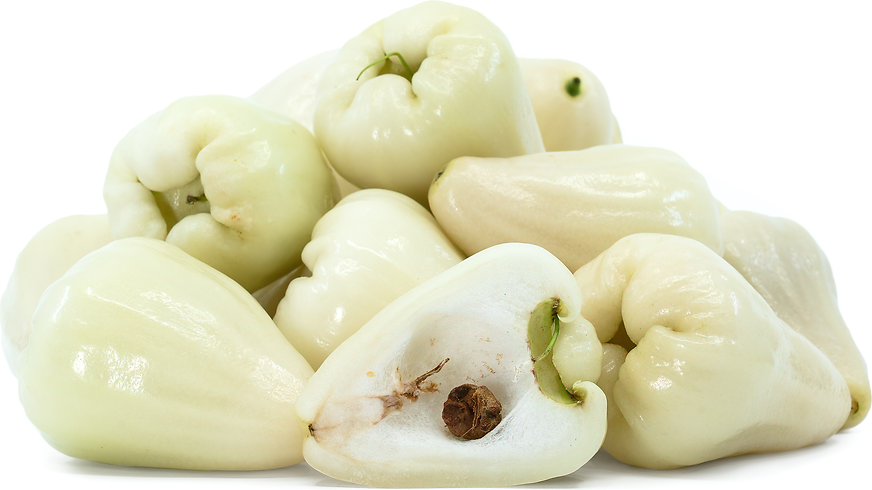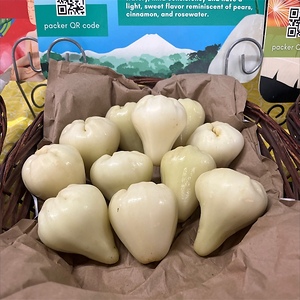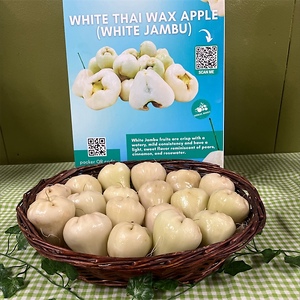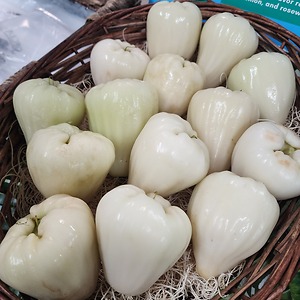


White Jambu
Estimated Inventory, lb : 0
This item was last sold on : 07/21/24
Description/Taste
White Jambu fruits vary in size, depending on the specific variety and growing conditions, and average 3 to 6 centimeters in length and 4 to 5 centimeters in diameter. The fruits typically appear in a broad pyriform shape with a curved, flattened base tapering to a narrow stem end. Some consumers mention they look like bells growing on trees. The curved base of the fruit is comprised of four puckered calyx lobes, and as the fruit ripens, these calyces extend outward and unfold. The skin is thin, smooth, lightly ribbed, and waxy, being easily bruised or damaged. The delicate skin also ripens to shades of ivory, pale green-white, to cream-colored, and the surface will have a glossy nature. Underneath the skin, the white flesh is dense, crisp, and aqueous just below the surface, and as it gets closer to the center of the fruit, the flesh develops a spongy, light, and cotton-candy-like consistency. Each variety will have a different consistency, ranging from dry and airy to crisp and succulent. The flesh also encases 1 to 2 black-brown seeds or is found seedless. White Jambu releases a mild, sometimes undetectable scent. The fruits are edible once ripe and have a subtle, light, sweet, tart taste, depending on the variety, with nuances of rose water, cinnamon, and pears.
Seasons/Availability
White Jambu fruits are available year-round, with a peak season in the summer.
Current Facts
White Jambu, botanically classified as Syzygium samarangense, is a tropical fruit belonging to the Myrtaceae family. The pale-hued variety is native to Southeast Asia and grows on an evergreen shrub or small tree in warm climates, reaching up to twelve meters in height. White Jambu is known by several names worldwide, including Wax Jambu, Wax Apples, Water Apple, Java Apple, Bell Fruit, Wax Jamun, and White Wax Jambu. It is important to note that there are over 1,100 species within the Syzygium genus. Many of these species may have similar characteristics, resulting in the fruits being called by common interchangeable names in Southeast Asian markets. White Jambu fruits are favored for their airy, light, and crisp consistency and mild taste. A mature Jambu tree can produce up to 317 kilograms of fruits per year, and the fruits grow in clusters over the branches and trunk. The fruits must be hand-picked to prevent their delicate skin from being damaged, and the fruits are harvested ripe as they will not continue to mature once picked. White Jambu fruits are one of the rarer varieties within Syzygium samarangense, but the species, as a whole, is one of the most commercially grown types in tropical regions worldwide for sale in retail markets. White Jambu is regarded as a delicacy and is primarily consumed fresh, but it is also versatile, used in cooked culinary dishes and various beverages.
Nutritional Value
White Jambu fruits are a source of fiber to regulate the digestive tract, potassium to balance fluid levels within the body, and calcium to support bones and teeth. The variety also provides magnesium to control nerve functions, vitamin C to strengthen the immune system, phosphorus to repair tissues, and iron to develop the protein hemoglobin for oxygen transport through the bloodstream. In Traditional Chinese and Ayurvedic medicines, jambu is occasionally used to cleanse the digestive tract and reduce flatulence. The fruits are also used in remedies to soothe sore throats and are an ingredient in a laxative powder known as Kayam Churna.
Applications
White Jambu fruits have a mild, light, and subtly sweet taste suited for fresh and cooked preparations. They are popularly consumed out of hand as a refreshing, cooling treat. White Jambu fruits are also sprinkled with sugar or salt or dipped in chili paste as a savory-sweet snack. Throughout Southeast Asia, White Jambu fruits are chopped and tossed into green salads and fruit medleys, and they are valued for adding crunch to dishes such as Indonesian rujak. They can also be blended into various juices and other beverages. In addition to raw dishes, White Jambu fruits are stewed with apples, sauteed, and mixed with vegetables, or added to soups and curries. They can also be pickled for extended use, used to make vinegar, or fermented into fruit wine. The airy fruits are favored for cooking into jams, jellies, and syrups or used as a garnish and filling flavor in desserts and ice cream. White Jambu fruits pair well with aromatics such as spring onions, chiles, and ginger, herbs including mint, basil, and cilantro, toasted cashews, pineapple, and lime. The fruits are highly perishable and will only keep for a few days and should be immediately consumed for the best quality and flavor. White Jambu fruits can also be stored in a container in the refrigerator for 1 to 2 days, but moisture is rapidly lost from the flesh each day it is not eaten.
Ethnic/Cultural Info
Jambu fruits are favored in Asia for their crisp and refreshing consistency and are believed to have cooling properties when consumed on hot, humid days. Balancing internal body temperature is an important practice utilized in Traditional Chinese Medicine, and consuming cooling foods is believed to help protect the body's overall health against sickness on warm days. Cooling foods should only be eaten when heat needs to be removed from the body and follows the principle of balancing yin and yang energies. It is important to note that the term cooling refers to the effect that the fruit has on the body and not on the temperature of the fruit.
Geography/History
White Jambu fruits are native to Southeast Asia and have been growing wild since ancient times. Possible centers of origin are mentioned from the Malaysian Archipelago to the Andaman and Nicobar Islands. White Jambu was initially foraged from wild trees as a food and medicinal ingredient, but over time, communities began cultivating and breeding the fruit for improved growth characteristics. The species was eventually spread via trade routes and human intervention to tropical regions worldwide and was naturalized in rainforests and warm areas. Jambu was thought to have been introduced into the Caribbean sometime before the 20th century, and the species was also planted throughout Central and South America. In 1960, a few select Jambu species were sown in Florida by Bill Whitman, fruit pioneer and the first president of the Rare Fruit Council International in Miami. Today, White Jambu is commercially cultivated in Malaysia, Indonesia, Thailand, and Taiwan and is planted worldwide in home gardens. When in season, the fruits are found in fresh markets and through specialty distributors.
Recipe Ideas
Recipes that include White Jambu. One
| My Family Recipes |
|
Apple, White Jamun, Walnut Salad |
| Suwannee Rose |
|
Jambu Salad |
| Suwannee Rose |
|
Jambu Salad |










